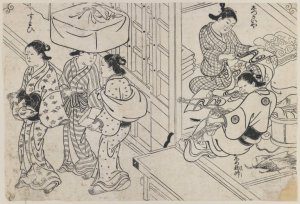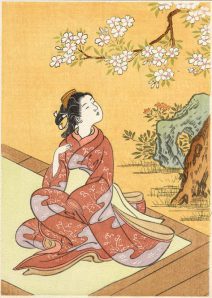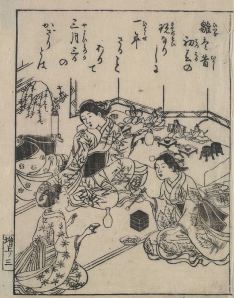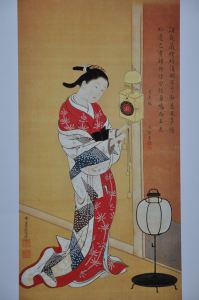Art of Japan and Old World of Kyoto: Nishikawa Sukenobu and Women in Society
Lee Jay Walker
Modern Tokyo Times
Nishikawa Sukenobu was born in 1671 and until his death in the middle of the eighteenth century, this stunning artist opened up aspects of the role of women in Japanese society. Also, with Sukenobu being based in Kyoto then this provides a rarity within the ukiyo-e art movement. Therefore, with Sukenobu being based in the imperial city of Kyoto this provided him with more freedom and his thinking would be influenced by the environment he resided in.
It is stated about this stunning artist that his images of women were more natural and unassuming and this fact left a lasting legacy. From the political point of view, he appears to have been disenchanted with bakufureforms which were infringing on artists. However, instead of accepting these reforms he appears to have rebuked the bakufu by expressing his thinking through his artwork.
Jenny Preston, School of Oriental and African Studies, University of London, comments that “Between 1710 and 1722, Sukenobu published some fifty erotic works; following the Kyôhô reforms of 1722 outlawing erotica, he began producing works generally categorized as fûzoku ehon — versions of canonical texts, poems and riddles, all executed in a contemporary idiom. This study contends that these works were an expression of political disaffection; that Sukenobu used first the medium of the erotic, then the image-cum-text format of the children’s book to articulate anti-bakufu and pro-imperialist sentiment. This radical re-reading of Sukenobu’s work is supported by close reference to the literary output of his numerous collaborators, to contemporary diary and pamphlet literature, and to the corpus of Edo and Kyoto machibure edicts. The study will hopefully shed new light on the role of popular art in the eighteenth century, and its profound political engagement.”
The research by Jenny Preston is very important because it highlights that artists couldn’t be fully constrained by bakufu reforms in their entirety. If, like stated, he had pro-imperial sentiments then this confirms his attachment to Kyoto and the power mechanisms of this city. Also, it shows that the bakufu would tolerate certain dissent in this period but at the same time central institutions were worried about the impact of art when it was deemed unsavory to the sentiments of the bakufu.
The University of Alberta Art Collection website comments that “Nishikawa Sukenobu was a Japanese woodblock print designer, book illustrator and painter. Unlike most of his contemporaries, who worked out of Edo, Sukenobu was based in the imperial capital, Kyoto. He produced book illustrations for the celebrated Kyoto publisher Hachimonjiya Jishō, as well as drawings for several kimono pattern sample books which portray scenes of women choosing kimonos. Sukenobu is best known for his orihon (folded books) and for his unsurpassed skill in presenting graceful and charmingly realized beauties. Sukenobu’s work greatly influenced numerous artists throughout the history of ukiyo-e.”
This bio by the University of Alberta is just highlighting brief facts about Sukenobu but it is clear that this individual artist is viewed with great acclaim when it comes to his depiction of women. Also, the Kyoto angle is highlighted and clearly Sukenobu is opening up a window to the fashion styles of this period in Kyoto. Similarly, he is providing a glimpse into the world of Kyoto with regards to the role of women in society.
Therefore, irrespective if the glimpse is limited or based on a male perception, it is still of cultural importance because his images are very realistic. For this reason, Sukenobu is of great importance because he opens up the keys to imperial Kyoto and the freedoms of women within certain areas of life.
His artwork called Appreciating 100 Women (Hyakunin joro shinasadame) is highly acclaimed because he covers a broad spectrum of different themes. This focus also highlights that his world was very rich and that he could mix easily irrespective of the situation. Therefore, Hyakunin joro shinasadame focuses on issues from the empress to ladies who were employed in the sex trade. Also, irrespective of the subject matter in this series of images, the importance is the style he did this in because the images are very realistic and this reality is what makes his work so powerful.
In another article about Sukenobu which was published by Modern Tokyo Times it was stated that “…with Sukenobu focusing on women from various different classes then he opens up the reality of old Japan. This in itself is very fascinating because it provides glimpses into the Edo period and this applies to stratification, roles of women, and freedom of women in Japan in this period. Therefore, the Hyakunin joro shinasadame is very important with regards to not only art but because it also relates to social issues and thought patterns of the day.”
“Sukenobu also highlights aspects of fashion with regards to elegant kimono designs. Indeed, many kimono-makers commissioned Sukenobu because of his creativity and the fact that he focused heavily on beautiful women and their lifestyle. Therefore, kimono-makers believed rightly that he could focus on new textile designs and this fact highlights the popularity of his work.”
The political angle to Sukenobu is also extremely fascinating and the same applies to the huge cultural differences within Japan. Imperial Kyoto had many different political intrigues and the world of Sukenobu meant that he was mainly an “outsider” in the world of ukiyo-e.
http://www.scholarsresource.com/browse/artist/2142567952
http://collections.museums.ualberta.ca/uaac/uaac/details.aspx?key=18058&r=1&t=1
http://www.soas.ac.uk/jrc/awards-and-grants/kayoko-tsuda-bursary-recipients.html
Modern Tokyo News is part of the Modern Tokyo Times group
http://moderntokyotimes.com Modern Tokyo Times – International News and Japan News
http://sawandjay.com Modern Tokyo Times – Fashion
https://moderntokyonews.com Modern Tokyo News – Tokyo News and International News
http://global-security-news.com Global Security News – Geopolitics and Terrorism
PLEASE JOIN ON TWITTER
https://twitter.com/MTT_News Modern Tokyo Times
PLEASE JOIN ON FACEBOOK
https://www.facebook.com/moderntokyotimes
Some art and cultural articles by Modern Tokyo Times are republished in order to inform our growing international readership.




